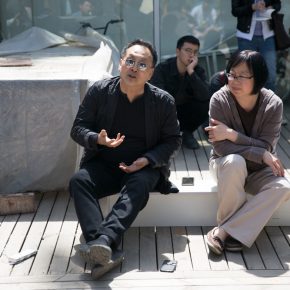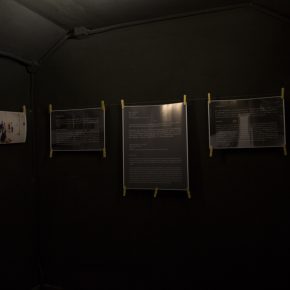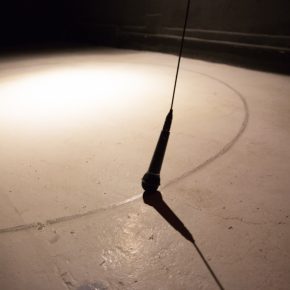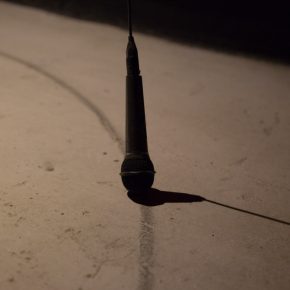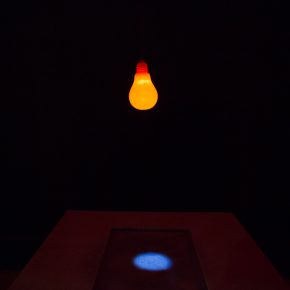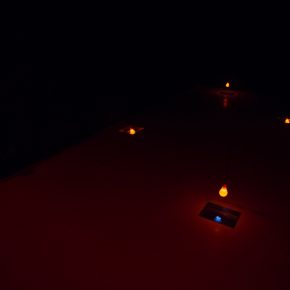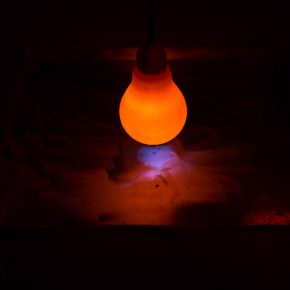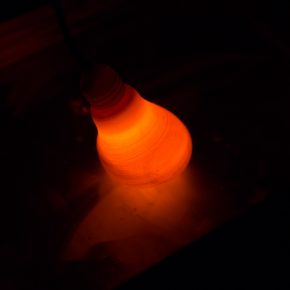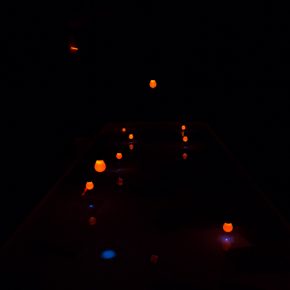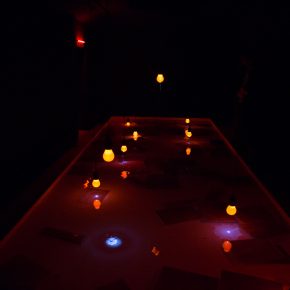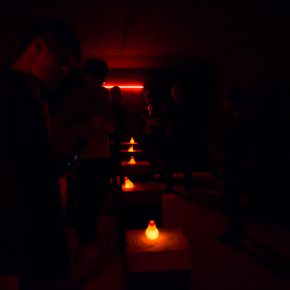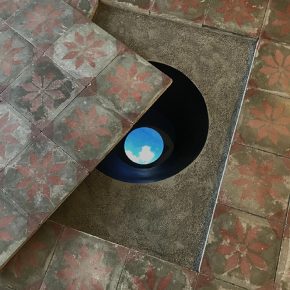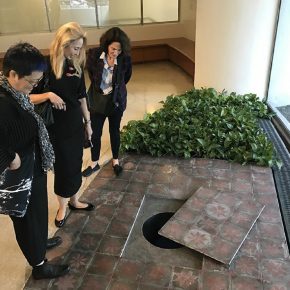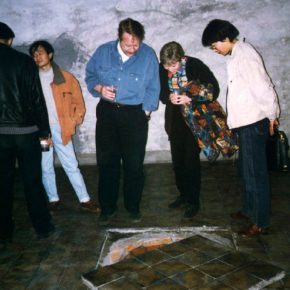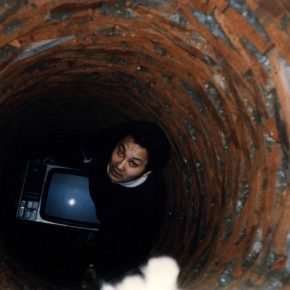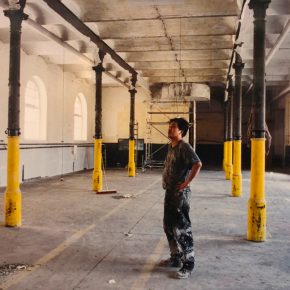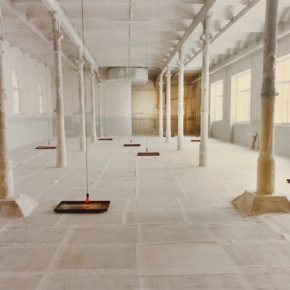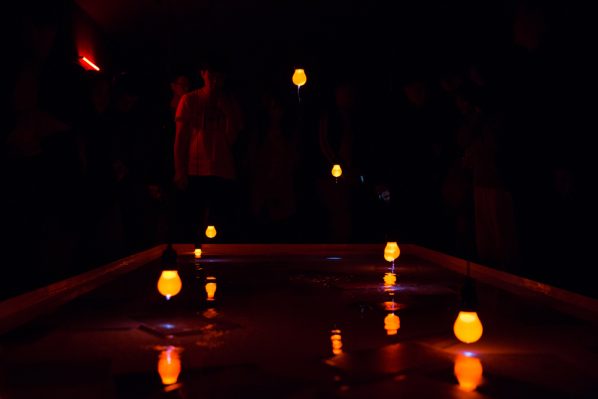
How to interpret an exhibition, what is the key? This is a problem that exists, which is easily overlooked, but the answer varies from various perspectives. When we are confronted with an unfamiliar and novel exhibition, it is a necessary and useful attempt to find a way to perceive the charm of art through the exhibition and works. The reply from Wang Gongxin’s solo exhibition “Under the Shadow–About BIAO” to this question in the Bunker provides an interesting discussion.
Watching an exhibition is like the metaphor of “stream” from the German dramatist Bertolt Brecht. The viewing process beyond the “stream”, near the “stream” and in the “stream” cannot be separated from the elements related to the exhibition. These elements are far-reaching, profound and shallow, and they all become ways to understand exhibitions and works. But from Wang Gongxin’s solo exhibition, it can be found that space, as the entrance to comprehend the exhibition, is how to make the exhibition sneak into the shadow of the space.
I Exhibition and Space
Some exhibitions are born for space, while others are independent of space. Wang Gongxin’s solo exhibition “Under the Shadow–About BIAO” is an exhibition designed for space. A unique spacious venue often adds unexpected effects to the work, but whether it has a relative meaning depends on the inherent logic of the exhibition. Wang Gongxin’s new solo exhibition was chosen to be displayed in the Bunker in the southwest corner of No. 3 Zhang Zizhong Road. The courtyard was once the temporary ruling place of Duan Qirui. Previously, there was a “March 18 Massacre” in front of the courtyard. The Bunker was the former underground fortifications built by Yasuji Okamura, a commander of the Japanese Army in North China. The basement of the Bunker is interconnected by five long box-like rooms. The epochal changes filter a taste of history, but this exhibition enables history to have a short breath. The first room in the Bunker cannot accommodate too many people. The photos and texts on the wall provide an explanation on the opening of the work. Why is the exhibition called “Under the Shadow–About BIAO”? This exhibition is related to Wang Gongxin’s exhibition of BIAO, twenty years ago at the art space of No. 10 Ludwigsburg in Stuttgart, Germany. He used traditional Chinese manual paper to plaque (BIAO) to paste the entire space, 10 pieces at the bottom of the tray contain the fixer which is then covered with the original photo of the copying landscape and the red light bulbs of the dark room are hung on the top. From the surface (BIAO), to the decoration (BIAO), to the expression (BIAO), the questions related to BIAO are answered. The first space presents the spectator with an experience on the “stream”.
II Artist and Space
As the creator and owner of the art space, the artist often connects and replaces various spaces. Since ancient times, artists have been exploring the mysteries of space, and they become the masters of space making. Wang Gongxin’s works are full of concepts about space, both obvious and sharp, both diverse and concealed. The artist himself seems to be reluctant to advertise certain ideas, and he just hopes to show a hidden retrospect through the exhibition. Wang Gongxin’s life journey has experienced a variety of spaces. He comes from China, lives in New York, and has exhibited in Germany. His actions are a matter of space. The versatile space has a perceptible continuity, which does not only make the work traceable, but also creates new ideas for the works. This is not just the existence of his artistic creations, which also provide a reference and an interpretation for future creations. Wang Gongxin’s treatment of spatial elements in art makes his work give them a symbiotic and eternal life. 20 years ago in the exhibition of BIDO in Ludwigsburg, Stuttgart, Germany, and the exhibition of “Under the Shadow–About BIAO” in the Bunker of No. 3 Courtyard of Zhang Zizhong Road, Wang Gongxin presents his exhibition in two spaces which are interspersed and infiltrated to a certain sense. In the second space of the exhibition, the sound intervenes into another sense, the microphone is close to the ground, suspended, and rubbed on the ground in a circular trajectory. The friction sound is transmitted to a vibrating device and converted into an area of beating sand. The red light bulbs hanging on the installation watch the jump of the sand. The sensory space is converted and the red light bulbs usher in the language of the next space.
III Spectators and Space
As one of the purposes of an exhibition, the spectator is the most important sensory collector of the exhibition. Space endows the work with meaning, which is the best way to evoke thinking by perception. Entering the third room, the vision is guided by the light and shadow of the red light bulbs in the darkroom. There are six pools cut on the surface. The tank is filled with fixer and the space is integrated with the work. The six red bulbs maintain a different vertical distance from the pool, some have been immersed in the fixer, and some face each other. The exhibition space was cut to break the concept of the original space in the viewer's mind. This cutting and intervention is the most impressive place for spectators. Just like Wang Gongxin’s “The Sky of Brooklyn” exhibited at home in 1995, visitors can understand the work through space and the artist’s intention through the work. The spectator's perception of space is often an intuitive perception. When a work is integrated into space, space will endow the work with a perception of the potential, and spectators will enter the aesthetic pleasure under this potential. On another level, the spectator’s comprehension of space is also to evoke the existence of another subconscious space, to enter the familiar space through an unfamiliar space, and to connect the work with the familiar space, thus creating a new sense of individual feeling.
IV Time and space
Time has its own unique meaning as an element that cannot be ignored in comprehending the exhibition. The significance of time in the exhibition space is more involved in the exhibition space, works and visitors. The Bunker represents a static time, the work represents a time that is happening, and the viewer is the coordinate of time. Entering the fourth space, the huge pool occupies most of the room. Ten red bulbs move slowly up and down through the device above the pool. Water droplets flow out from inside the bulb. In addition to the fixer and the paper that is immersed in the water pool, if you want to see the pattern on the paper in the darkroom, you can only find the words in the water when the light bulb touches the pool. As a material existence, the Bunker makes time flow into the memories of history, and the consciousness and form of historical events become the signals of interpretation. With the existence of time, the works temporarily perceive the existence of the viewer's self through the existence of works in the space. As a time coordinate, viewers can touch the meaning of the work through history, at present and in the future, so as to interpret the work on a multi-dimensional level.
V Space and space
Space is not only the source of significance in the exhibition, but also the black hole of some important information. Beyond the limited space are more blank spaces. Do we have to believe in all the content that the artist has shown? Instead, question the gap behind this space. In the fifth room, the artist displayed the concrete part cut from the ground in the third room on the exhibition stand. The cut parts are embedded with red light bulbs and a monumental display. In addition to responding to the third space, there is a more inexplicable eternity. Although it is a short-term spectacle, it leads the thinking of people to the blank area outside the exhibition. Judging from the location, the curator, the sponsor, the artist, the media, and the visitor, the perspective from the visitor might be the most sincere and utilitarian, other attitudes expressed by other parties through the exhibition, whether they are just hidden. Or what you expect to mention is the purpose, whether the blank space is the source of the secret? It may be that the excessive interpretation will bring a burden to the spectator, but the charm of art is that it is unpredictable but enjoyable.
Space is the artistic proposition that Wang Gongxin has been exploring. His works also guide the visitor to a perspective. As for the title “Under the Shadow–About BIAO”, his exhibition is a shadow that sneaks into space.
Text by Lin Lu, translated by Sue/CAFA ART INFO
Photo by Yang Yanyuan/CAFA ART INFO


